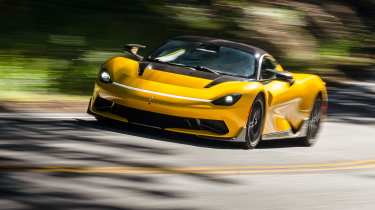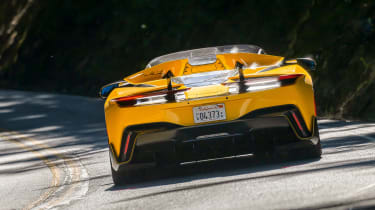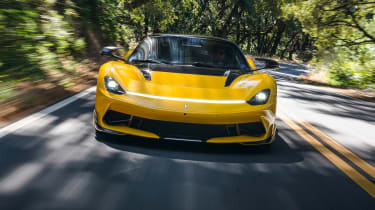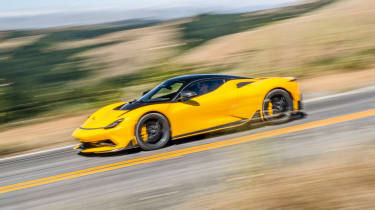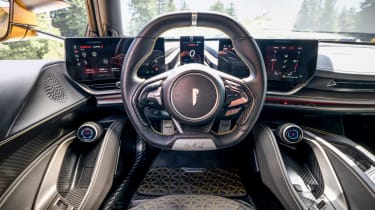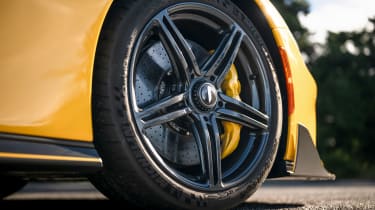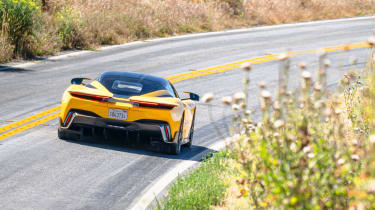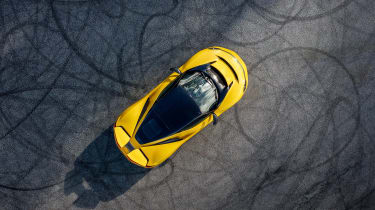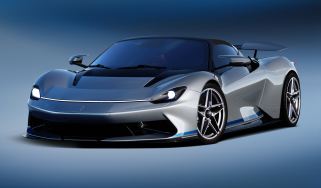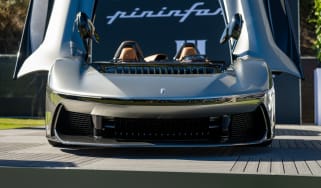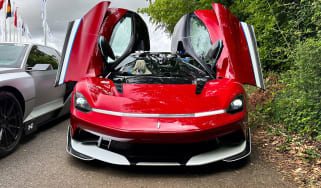Pininfarina Battista 2023 review – world's quickest production car driven
You’d expect gorgeous lines from Pininfarina; you might not expect 1874bhp and acceleration to make you nauseous. We drive the dizzying Pininfarina Battista
The Battista’s natural frequencies don’t readily resonate with those of the petrolhead. We interpret its rakish Pininfarina-penned lines and understand its speed well enough, but we prefer to converse in the relatable century-old language of cubic capacity, cylinders and horsepower, not kilowatt hours, lithium nickel manganese cobalt oxide batteries and permanent magnet AC synchronous motors.
No matter. These might be uncomfortable times for dyed-in-the-wool car fans, but if you embrace the fact that the EV supercar’s job is in part to create a degree of dissonance, then the existential fear fades. Better, when presented with the opportunity to drive one, you’re less concerned with the nomenclature and more engrossed in discovering how this new-age exotica speaks to you and works with the road.
> Limited-run Pininfarina Battista Edizione Nino Farina makes debut
As you’d expect from arguably the greatest of all Italian automotive styling houses, the Battista is an immaculate piece of work. Subtle, yes, but in shunning in-yer-face futurism it achieves a more classical elegance. This might seem at odds with the sledgehammer performance promised by its near-1900bhp Rimac-sourced powertrain, but the paradox between explosive pace and visual grace is something Pininfarina has clearly enjoyed exploring.
Indian ownership, Croatian underpinnings and engineering and manufacturing teams divided between Germany and Italy are a curious mix for any car, but Mahindra’s discreet stewardship and the largely hidden nature of Rimac’s EV hardware ensure the Battista is a cleanskin onto which Pininfarina has imprinted its own identity. And not just in the way the car looks. The extent to which Automobili Pininfarina’s engineering input defines the Battista’s dynamics shows admirable commitment and deft skill and brings meaningful authenticity to the project.
It’s common knowledge that the Battista shares a great deal of its hardware with the Rimac Nevera. No point getting hung up on it, because Rimac is to the EV supercar what Cosworth was to F1 teams in the DFV era. And indeed low-volume petrol-powered supercar and hypercar programmes in the 2020s. There’s no shame in going to the best.
Automobili Pininfarina takes delivery of Battista rolling chassis from Rimac with all the powertrain installed and all four corners (suspension, brakes, etc) fitted, whereupon the cars are completed in a painstaking by-hand process at Pininfarina’s Cambiano production facility. This is also home to the Pininfarina Automobili ‘Atelier’, where customers can visit to go through the process of deciding on colour, trim and extensive personalisation that ensures no two Battistas are the same. There are two levels of car: the regular Battista and the full Furiosa spec, which we're driving here, the latter featuring a more overt nose-to-tail aero package for increased downforce and visual drama.
This build process is standard stuff, but the development of the Battista is more intriguing. It would be easy to assume the deal with Rimac was for a naked Nevera right down to the last line of code. That would be the easiest route. But instead Pininfarina decided to do all its own dynamic development, recruiting a small team of crack engineers and conducting an exhaustive development process at the world’s leading proving ground facilities, just like all the big OE manufacturers.
The man in charge of this daunting task is Georgios Syropoulos, chassis dynamics manager and chief test driver for Pininfarina Automobili. His CV is impressive, with five-plus years learning his craft as a ride and handling engineer at Lotus before moving to Tesla in 2013. In 2017 he switched to Faraday Future, eventually joining Pininfarina at the end of 2019. Clearly he knows new tech inside-out, but it’s the foundation he gained at Lotus that’s of most interest to people like us, because it means he knows what the best analogue cars feel like.
It’s testament to everyone involved in the Battista programme that they managed to work under the extreme challenges of the pandemic. And once lockdown restrictions ended, the workload was mountainous – Syropoulos reckons he’s spent between 200 and 250 days away from home in each year since. Nobody said building supercars was easy.
We’ll get to the driving in a moment, but the development process for the Battista is just as revealing, because it highlights just how different this new breed of car is compared to a state-of-the-art ICE supercar. ‘Everything talks to everything else,’ explains Syropoulos. ‘You can integrate pretty much every aspect of the car. People tend to focus on the raw performance of these cars, but it’s the level of integration that’s the biggest step.
> Bugatti Chiron Super Sport v Rimac Nevera
‘It’s understood that the behaviour of a fully electric powertrain can be minutely controlled, but because we have four-wheel motors we have endless scope for torque vectoring. That’s pure torque vectoring, with no brake intervention. Thanks to the instant response of electric motors there’s no mechanical latency as you get with a combustion engine, so you can tune everything to the millisecond. Factor in brake-by-wire, steer-by-wire, adaptive dampers and an extensive suite of sensors monitoring movement in three dimensions and you can see that it’s possible to create a level of integration that gives the car a global view of what it’s doing and what you’re asking of it. In fact, we’ve got to the point where it uses all that information to predict what you’re going to do next…’
According to Syropoulos, exploring and refining the Battista’s dynamics was a huge voyage of discovery. One in which he kept releasing more performance and capability in the car. Where once he imagined there to be a limit, the Battista proved it could go beyond. Mapping this ever-expanding performance envelope must have been a colossal task. Likewise trying to seamlessly blend all the different areas of the car to the point where it works as one homogenous, fully integrated system. The fact it can then take all that information and reference it against the dynamic limits mapped out by Syropoulos to achieve a kind of spatial awareness, and then cross-reference it against your inputs to prepare itself for your next move is mind-boggling.
‘It doesn’t wait for you to do something or for something to happen,’ continues Syropoulos. ‘The system is working in real time and even fractionally ahead of real time. It’s working pre-emptively for you as soon as you turn, it’s there to assist you, to modulate the car, to predict your intention. And even if your intention was not what the system assumed, as soon as you try to do something different, the system is already a step ahead.’
Knowing this, and that there’s almost 1900bhp beneath your right foot, the moments immediately prior to driving the Battista are a little overwhelming. There’s a hushed ritual to start-up, a variety of hums, clicks and whirrs replacing a barrage of open-throated exhaust noise. Despite the calm, you subconsciously brace yourself for the coming assault on your senses, the act of dropping into the driver’s seat and pulling down the upswept door akin to the moment the rollercoaster operator pulls the restraining bar down over your shoulders before firing you into oblivion. It’s an overreaction, of course. But also a reassuring one in many ways, because true supercars should have that effect.
There are four set-menu dynamic modes – Calma, Pura, Energica and Furioso – plus a mix-and-match ‘Carattere’ mode where you can blend the attributes you like most. Calma is there to achieve the optimum WTLP range of 296 miles, and to offer the tamest of tame settings. Nonna Mode, if you like. Of course, being the Battista, this still means 670bhp, in this case all of it sent through the front wheels.
Each subsequent click of the rotary switch (which is mounted in the driver’s door) brings more power and torque along with a set of carefully crafted and entirely digital characteristics. Calma isn’t something you’ll use more than once, but Pura (999bhp and 1018lb ft) is a very soothing way to travel. The novelty of moving in near silence with the smooth sensation of being seamlessly pulled along by some invisible bungee cord is pleasingly at odds with the supercar surroundings of the cockpit.
As its name suggests, Energica is an amped-up mode in which you get to experience further uncorked performance (1475bhp and 1357lb ft) and feel the four-wheel torque vectoring at its most, er, energetic. The next click to Furiosa gives you the full 1874bhp and 1726lb ft but handles it with a more clinical dynamic character, the torque vectoring dialled back a little to give a more linear sense of rotation into corners that’s better suited to high-commitment cornering, or if you simply prefer a less augmented feel.
We’ll explore the straight-line performance shortly, but it’s the handling, and specifically the four-wheel torque vectoring, that deserves most discussion. The one-word summary is ‘voodoo’, but you could write a book on how this car feels. Such is the effect torque vectoring has on the rotational response and capabilities of the Battista, you’d swear the steering must have a variable ratio. Syropoulos insists it’s consistent across modes, and that it’s the way the vectoring is applied that creates such distinct feel and response. Energica provides the most vivid demonstration of this, the way the front end scribes a tightening line as the rear pivots like a shopping trolley is fascinating and scintillating.
For 99.9 per cent of the time the Battista’s super-smart pre-emptive poise is brilliantly prescient. The steering may be ‘by-wire’ but it gives you a clear picture of how hard you’re working the front tyres, and the brake-by-wire emulation (achieved with the world’s first application of Brembo carbon-ceramic brakes on a pure EV supercar) and the way it blends with regen is also extremely good.
The only question mark arises in fleeting and very occasional moments when your steering input isn’t quite matched by as much rate of turn as you expect. It’s not a fault in the steering per se, but it’s a little spooky because it feels like a split-second glitch in the torque vectoring matrix. It’s very slight, but because it’s the result of a mapped behaviour across multiple areas of the car rather than the mortal limitations of a passive, analogue, mechanical system, you feel less inclined to regard it as a quirk and more ready to see it as a failing.
As with all cars, the more seat time you have the more in tune you become, but the fact that I only felt this slight disconnect in Energica suggests it’s mode-specific. The fact I tended to drive in Pura or Furiosa modes also points to my well-documented preference for more linear, less exaggerated feel and response. Ultimately, the fact I found settings I could connect with is an indication of the inherently enjoyable nature of the Battista and the extraordinary level of detail Syropoulos and his team have worked to. And, being engineers, they will only refine and improve things as time goes on.
As it stands, the Battista feels like nothing else I’ve ever driven. The way it points into corners and changes direction you’d swear it weighs 1500kg, not a little over 2000kg. Likewise, the way it transmits 1726lb ft into patchy, polished Italian tarmac suggests the Michelin tyres are equipped with adamantium studs that deploy, Wolverine-style, under peak accelerative loads.
Unless you earn a living flying fast jets off the deck of an aircraft carrier, the amount of deployable performance is brain-scrambling to the point of nausea, but that’s the name of the game in an EV world. There’s nothing remotely pleasurable about hitting 62mph from a standstill in 1.86sec. As for 0-186mph in 10.49sec, that’s more like a dragster than a road car. A 217mph top speed is equally pointless, but since when have supercar capabilities been rooted in reality?
What I find far more appealing and impressive is the nuanced way in which you can flex all that muscle, the fun coming not from pulling the pin on that explosive, neck-snapping force, but rejoicing in the elastic and endlessly intensifying s-q-u-e-E-Z-E of propulsion. Similarly, the way you can use the regen to gently wipe off speed into a corner with a partial lift of the throttle becomes enormously satisfying. As ever, it’s the shades of grey that matter.
I’m increasingly certain the momentum behind the development of sustainable fuels means ICE-powered supercars will see me into my dotage. I think most of us will take comfort from that thought, even if we’re never likely to own one. What that scenario might mean for EV supercars like the Battista is hard to say.
In the short term there’s an obvious novelty value for collectors who have the money to indulge in an exotic EV that provides a wild contrast to their petrol-powered cars. If they enjoy driving it and don’t lose their Henry Poole shirt when they come to sell, they might just buy another. However, the bigger play is putting stars in the eyes of today’s kids, who will grow up only ever knowing EV family cars.
Whether the Battista (or indeed the Rimac Nevera or Lotus Evija) will become their dream car is a question I can’t answer. Perhaps the anarchic thrill of a shrieking V12 will prevail. What I do know is I enjoyed the overall experience. I’m not a fan of how extreme EV propulsion feels, but once I (quickly) learned you don’t have to hammer the accelerator, I became increasingly fascinated by what the Battista does, how it does it and what wholly digital dynamics will bring in the not too distant future.
You don’t have to like the idea of the Battista and its kind. Still, I think we can all agree that it’s apt that a proud Italian name – one free from the baggage of petrol-powered legacy product – is doing great things in order to reassert the supercar’s rightful status as apex predator of the EV world.
Pininfarina Battista specs
| Motors | Four, 1400kW total |
| Power | 1874bhp |
| Torque | 1726lb ft |
| Weight | 2063kg |
| Power-to-weight | 923bhp/ton |
| 0-62mph | 1.86sec |
| Top speed | 217mph |
| Basic price | c£1.96 million |
This story was first featured in evo issue 313.
